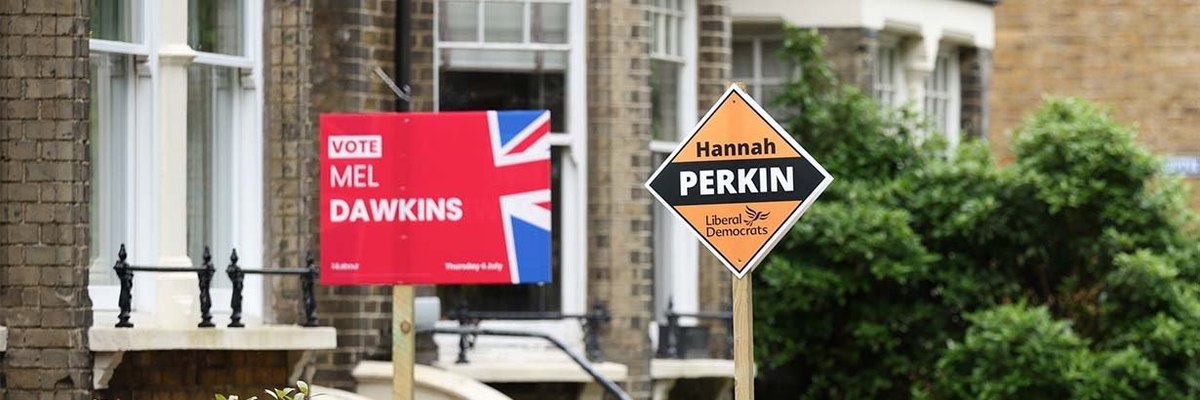Labour are the country's favourite party, but the Lib Dems have the broadest popularity
The general election two weeks ago was, of course, the ultimate popularity test for Britain’s political parties, with Labour undoubtedly coming out on top. But a ‘first past the post’ election can only tell us so much about how Britons really feel about the parties on offer. As we saw in the campaign, 22% of voters intended to use their vote tactically for a party other than their sincere first choice. And there’s only the ability to cast a single vote for one party, meaning attitudes to other parties don’t get recorded.
Asking people to rank the main parties on offer in order of preference reveals an alternative perspective on who the most favourably viewed parties are.
Of the five main GB-wide parties, the Lib Dems are the least likely to be somebody’s favourite party, at 13%. But looking at wider preferences suggests they have broader favourability than the other options – being in the top three choices of 79% of Britons, more than any other party. Reform UK, conversely, is more divisive, with nearly half of the public (48%) ranking the party as fifth or lower*.
In terms of overall favourite party, Labour still retain a clear lead – being the first ranked option of 28% of Britons, even if it is down on the 35% of the vote they won in the election. They are followed by the Conservatives, who are the first preference for one in five (21%), and Reform UK, who are the most favourably viewed party for 18% of people. The Greens see the biggest change from their vote share (7%), being the top choice for one in six people (17%). This fits with Green supporters being the most likely to vote tactically.
The Greens’ ‘hidden’ popularity comes primarily from Labour and Lib Dem voters, with 16% and 14% respectively ranking the Greens higher than the party they voted for. Other sizeable differences between votes and favourites can be seen with Labour and Lib Dems exchanging a clear number of likely tactical votes, as well as one in ten (10%) Conservative voters really preferring Reform.
While the Greens are the largest alternative first choice of Labour voters, they are not their overall second choice, with that title remaining with the Lib Dems, whom 43% of 2024 Labour voters rank in second place, as do half (51%) of those who rank Labour first.
But it’s important to note that, across the board, second choices are rather diffuse. No party gets substantially more than half of any party’s second preferences. Those ranking Reform first split most decisively, but still only 54% go to the Conservatives. Tories are most divided on who to put second, four in ten going to Reform next, with three in ten going to the Lib Dems and one in five to Labour.
How do the parties compare against each other?
Taking all preferences together allows the creation of head-to-heads, showing which party voters prefer in each pairing and avoiding the issues with second rankings getting split between more similar parties.
Labour are the ‘Condorcet winners’ here, meaning they beat every other option when considered one-on-one. This includes being preferred over the Conservatives by six in ten (61%) Britons and by nearly two-to-one (65% vs 35%) over Reform. Labour’s closest race is against the Lib Dems, who themselves beat every party other than Labour when going head-to-head (and actually beat Labour 58% to 42% in the south of England). Reform struggle in this format, with just a third of the public (35%) preferring them over the Conservatives, Labour or the Lib Dems.
This format can also assess the viability of the sometimes proposed ‘merger’ of the Conservatives and Reform, which has been heralded as a solution to the two parties supposedly splitting each other’s votes and is supported by around half (47%) of Conservative members.
But these ‘head to heads’ highlight the problem with this ‘Lego-like’ view of voters. One-third (34%) of Conservatives rate Labour more highly than Reform, with a narrow majority (51%) opting for Ed Davey’s Lib Dems over Nigel Farage’s party. Reform voters likewise fail to uniformly favour the Tories over the alternatives, with a quarter (25%) ranking Labour and three in ten (30%) the Lib Dems ahead of the Conservatives. This suggests any such merger would struggle to carry all voters from both parties with it.
This diffusion of preferences on the centre-right can be contrasted with the progressive parties, whose supporters more consistently favour each other over the Conservatives or Reform. Only one in six (18%) of the public are consistently right-wing in their party preferences, i.e. favour the Conservatives and Reform over all other options. This compares to 40% who rank all progressive options ahead of the two major right-of-centre parties and 54% whose top-two choices are both of the ‘left’. For four in ten Britons, though, their rankings of the parties contain a mix of the left and right.
Ultimately, any potential political merger will have to contend with the fact that two different support bases cannot be perfectly slotted together, with this particularly true of the Conservatives and Reform, who are far from interchangeable in their respective supporters’ minds.
*respondents in England saw the five main GB-wide parties, while those in Scotland and Wales additionally saw the SNP or Plaid Cymru.
See the full results here
What do you think about the parties, British politics in general, and everything else? Have your say, join the YouGov panel, and get paid to share your thoughts. Sign up here.
Photo: Getty










